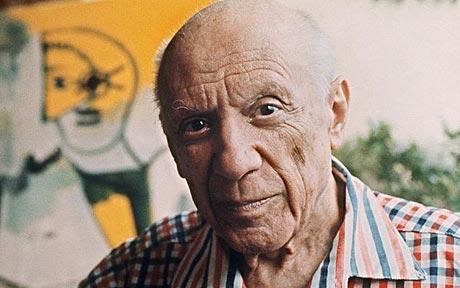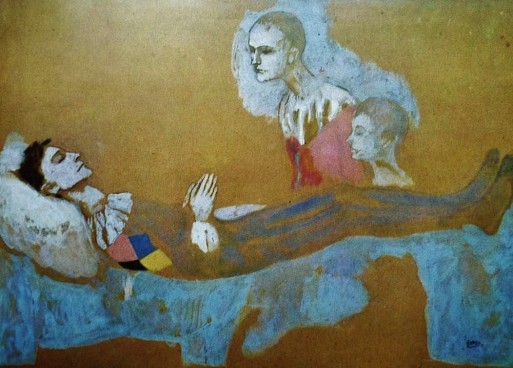You don’t have to be an art lover to know the name Pablo Picasso (1881-1973). But few would think to associate a Harlequin-esque character with the cubist legend.
The character of “Harlequin” shows up in a countless number of Picasso’s paintings (especially his Rose Period) and became the ideal personality onto which he could project his ponderings of life and death. One of the most powerful paintings of Harlequin is Death of Harlequin (1905), which shows a somber funeral scene after the entertainer’s death.
Why choose to work through Harlequin? He is, after all, a character who had no resemblance to the painter himself. The physical traits of Harelquin are far from discreet: his face eclipsed in white, while his body constantly overwhelmed by the gaudiness of his clothes. As far as we know, Picasso was never seen running around in a 15th century romper.
“Why choose to work through Harlequin? He is, after all, a character who had no resemblance to the painter himself.”
There are endless academic and arty ponderings as to why Picasso chose to paint Harlequin in his tableaux. A mythological perspective notes that Harlequin was “a mysterious character with classical origins,” who “had long been associated with the god Mercury and with Alchemy and the Underworld.” Perhaps Picasso was drawn to Harlequin for the dark undertones of the character’s peppy visage – it presented an opportunity for him to explore a harsh duality.
According the Met Museum, “Picasso has revealed the private sadness behind the public face of [Harlequin],” through “an interpretation that has greater resonance when one considers that the artist often regarded his clowns as representations of his alter ego.” In a way, Picasso played a similar role to Harlequin; he was never an entertainer per-se, but was expected to perform on a certain level as an artist for the public.
Death of Harlequin could very well show the exhaustion Picasso felt from such pressure. The image of Harlequin reclined in his garb, but also succumbed to death, represents the metaphorical death Picasso’s inspiration from time to time. With the constant pressure to “perform” well as a painter, it becomes easier to see the empathy Picasso could have felt with clowns like Harlequin. Another piece of information worth noting, says the Met, is the fact that Picasso was quite depressed at the time he painted Death of Harlequin, as his dear friend Carlos Casagemas had just committed suicide.
“As far as we know, Picasso was never seen running around in a 15th century romper.”
The tone of the painting is a bit undecided, walking the line between sadness and tranquility; helplessness and relief in the face of death. Harlequin and his mourners are bathed in white halos that seem to extend from their own face paint. The viewer doesn’t even see the legs of the table Harlequin is placed upon; instead he seems to float upon a cool, white portion of Picasso’s under-painting. Is Harlequin experiencing a peaceful death? Is he filled with regret after a life of tireless performance, or fulfillment? The wonderful thing about the work is, perhaps, its malleability: depending on our own mood, we can see a man reposed in peace, or surrendered to a life – and inspiration — exhausted.
What do you see in the face of Harlequin? We look forward to your comments below.
Related SevenPonds Posts:

 Pablo Picasso: Death of Harlequin
Pablo Picasso: Death of Harlequin





 First the Wealth Gap, Now the U.S. Has a Growing Health Gap
First the Wealth Gap, Now the U.S. Has a Growing Health Gap
 How to Comfort A Dying Loved One
How to Comfort A Dying Loved One
 Our Annual Seven Holiday Gifts for Someone Who Is Grieving, 2024 Edition
Our Annual Seven Holiday Gifts for Someone Who Is Grieving, 2024 Edition














